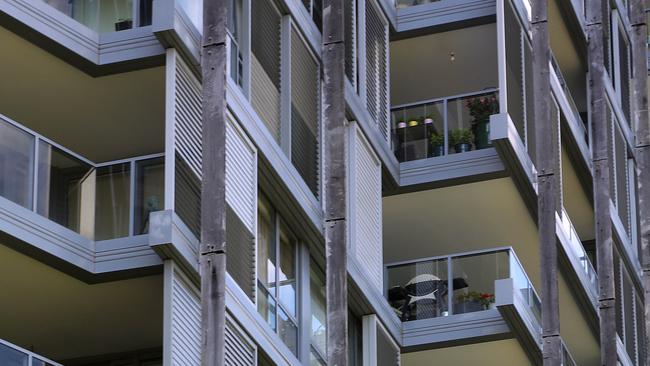New research reveals capital city rents are flat — and could even head down
EVERYTHING else might feeling like it’s going up in price but your rent shouldn’t be. That is unless you’re unlucky enough to live in one of three cities.

HEALTH insurance premiums are going up, transport fares always seem to be heading north and the Government still seems to be circling a multitude of taxes sizing up which one to hike.
But in a refreshing bolt from the blue, which is sure to leave many people going “wait, what did you say?” rents for houses and flats have failed to rise this year and are growing at their weakest rate since 1996. In fact, rents could even start going down over the next 12 months.
According to analysis by property data and analytics company CoreLogic, in the year to February 2016, rents were unchanged across the capital cities at an average of $488 per week for people living in a house and $467 for those in an apartment. The overall average rent is $485 per week.
People living in Darwin have been the biggest beneficiaries of the downward trend with rents slashed by 13.3 per cent. Costs have tumbled in Perth by 8.4 per cent and by around one per cent in Adelaide and Brisbane.
CoreLogic research analyst Cameron Kusher said landlords had little wiggle room to raise rents, “With construction activity set to peak over the next 24 months, and with many new properties still to settle, there is a real possibility that rental rates will fall over the coming months.
“For renters, it potentially means more surety in securing accommodation and the potential to upgrade into a higher level of accommodation for a similar cost,” he said.

IT’S NOT ALL GOOD NEWS
But, as ever, the picture is not black and white with renters in Australia’s two largest cities — where 40 per cent of the population lives — paying more.
In Sydney, renters are paying 1.5 per cent more than this time last year with rents hovering around the $600 a week mark. In Melbourne, the cost of renting rose even more, by 2.2 per cent. But at $453 per week, it’s still significantly cheaper to get a pad in Victoria’s capital than up in the Emerald City.
Rents in Canberra rose 1.6 per cent and they remained steady in Hobart which remains the cheapest major city to rent in at a mere $341 per week, almost half the cost of a place in Sydney.
Nationally, rents rose 0.3 per cent between January and February.
Steep annual rises in rents reached their peak around 2009 when, on average, the cost to live in the same property jumped by 8 per cent. But since then annual rent increases have been steadily going down to little more than zero now.

NO BUBBLE
Ms Kusher said the reason for the pressure on rents was too many houses and units vying for too few tenants, pressure on wages and lower rates of populating growth.
But while there might be excess rental capacity in the market, Commonwealth Bank economist Michael Blythe said talk of a housing bubble was overblown.
Mr Blythe told clients to be careful when comparing house prices over certain periods to ensure they were measuring “like with like”. He also said the growing size of houses should not be cause for concern, reported the Australian Financial Review.
“Our consistent view over the years has been that the rise reflects a shift in household preference and ability to access credit. And a shift in the type of housing we want to inhabit.”
Since 1985, the average floor area of a new house has risen by 49 per cent.
Jonathon Hedges, 25, and fiancee Lisa Spalding, 25, are renting in Gladesville, on Sydney’s north shore, but have bought a three-bedroom home in Caboolture, north of Brisbane as an investment.
Mr Hedges said property was too expensive in Sydney and the return was better in Queensland as the couple save for a dream home on the northern beaches.
“The rent pays the mortgage and I’m happy to hold on to it and keep it ticking over until there is some capital gain, or sell it and run,” he told the Daily Telegraph.
Those on poorer incomes were most at risk in the rental market, research last year by the Australian Housing and Urban Research Institute (AHURI) revealed. The percentage of rents which were affordable to lower income households fell markedly between 1996 and 2011 as increasing numbers of people who earnt more, and might otherwise be expected to buy, piled into the rental sector.
Between 2001 and 2010 around 1.7 million people shifted into the rental market with a third not returning to home ownership, the AHURI found.




